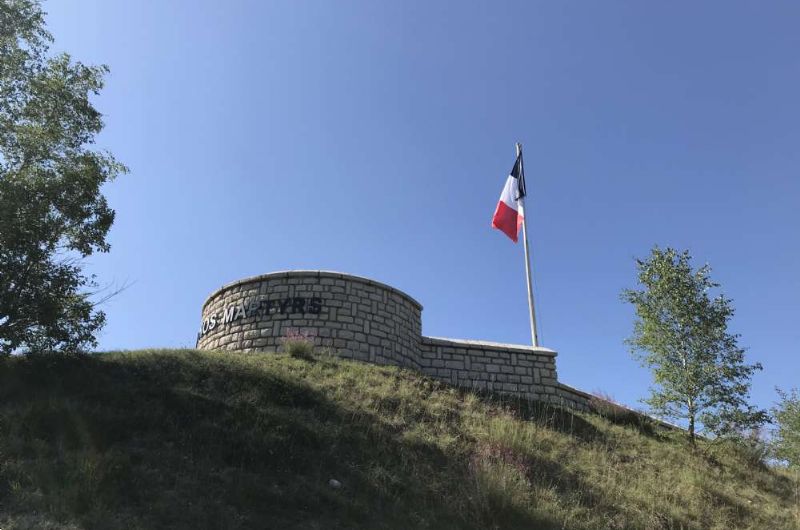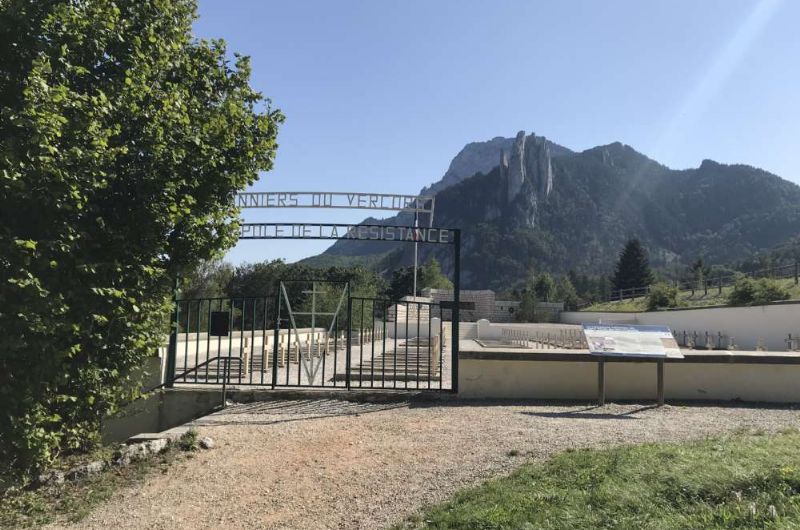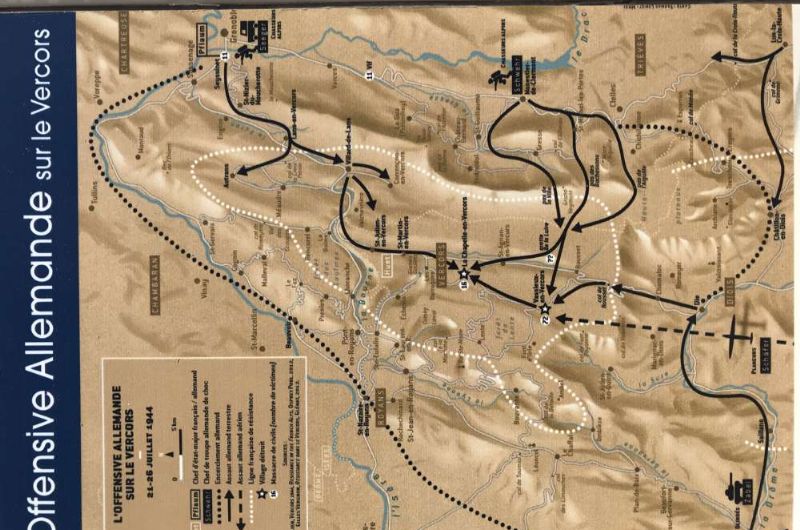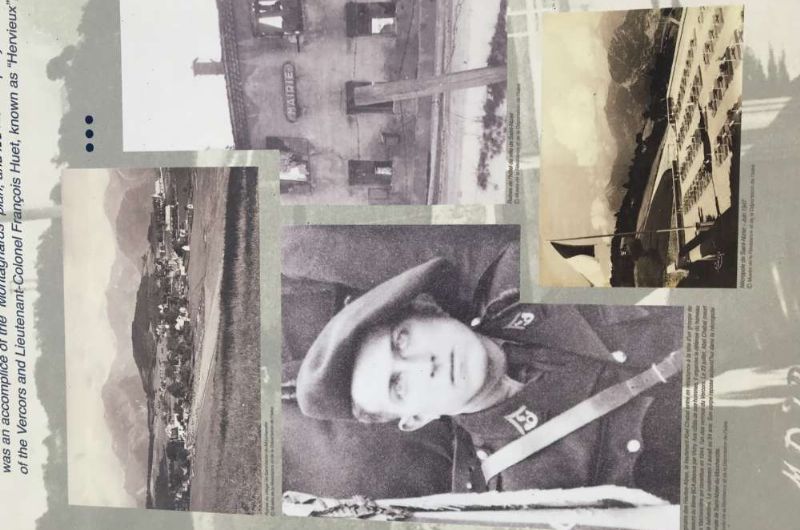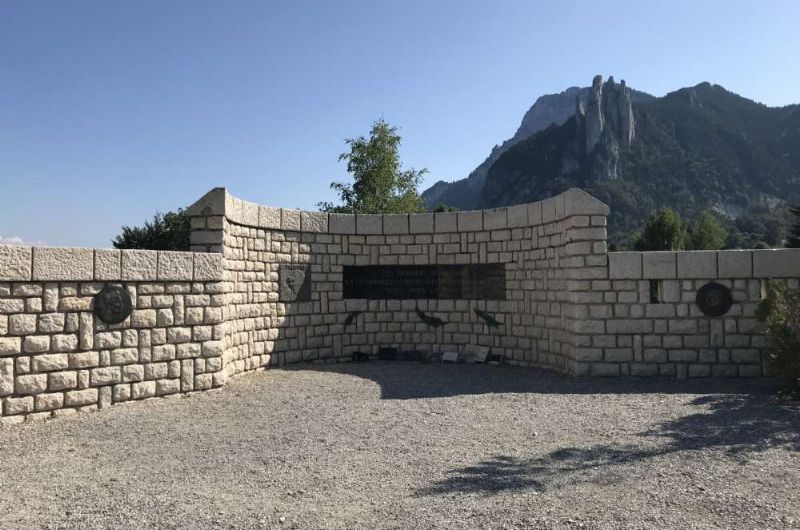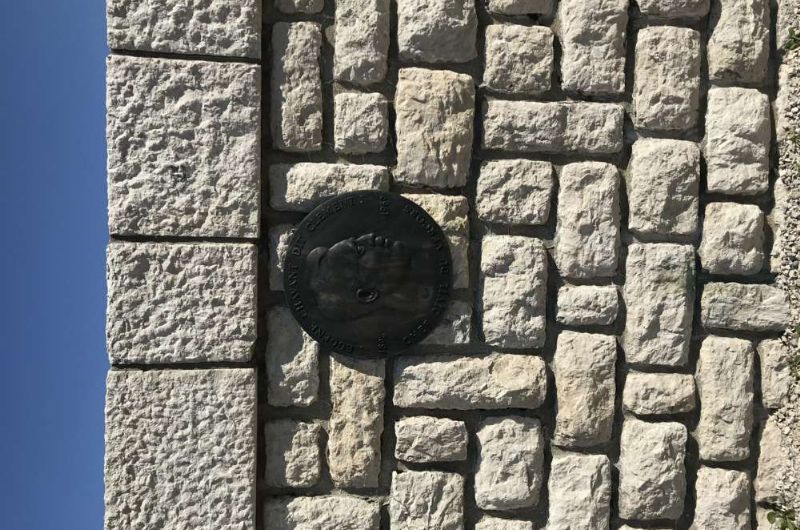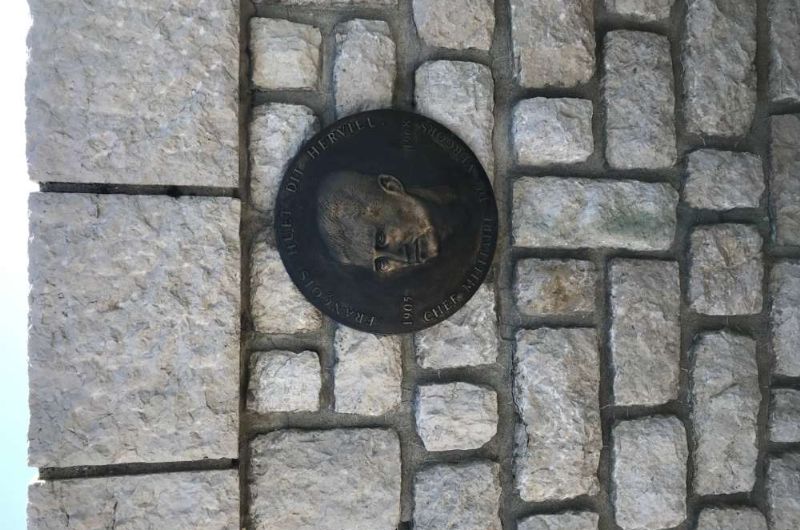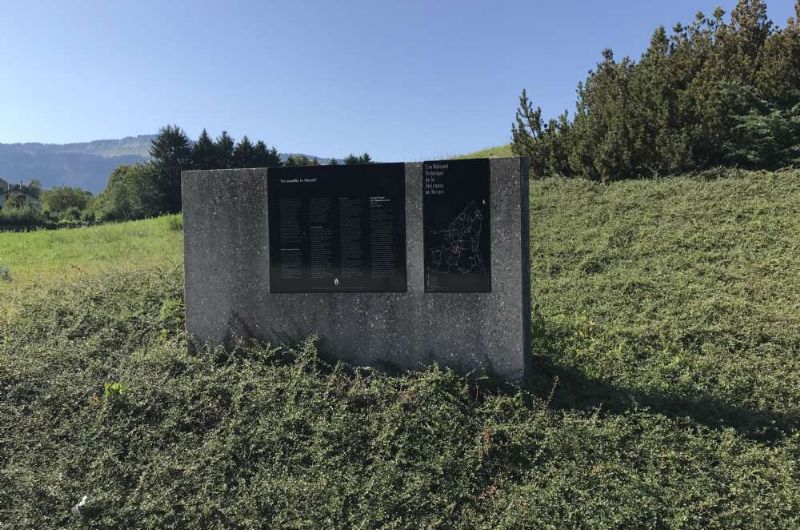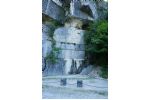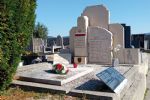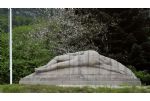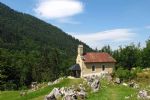Mémorial et Nécropole de La Résistance Du Vercors
Texte des panneaux
Surplombant Grenoble et devant l'un des plus impressionnants panoramas de la région, la nécropole nationale de Saint-Nizier-du-Moucherotte regroupe les dépouilles de soldats et de maquisards morts pour la France lors des combats du plateau du Vercors au mois de juin 1944. Créée en 1947, cette nécropole est située sur les lieux mêmes de cet affrontement. 98 résistants et deux maquisards yougoslaves y sont inhumés. Parmi eux, repose l'écrivain et journaliste Jean Prévost (1901-1944) dit « Godervilie ». Co-auteur du « plan Montagnards », il participa à la tête de sa compagnie aux combats des 13 et 15 juin 1944. Il fut tué le 1er août 1944 au Pont-Charvet près de Sassenage. Ce cimetière accueille également la tombe d'Eugène Chavant dit « Clement », te responsable civil du Vercors et le cénotaphe du lieutenant-colonel François Huet dit « Hervieux », dernier chef militaire du Vercors, ainsi que l'a souhaité l'Association nationale des Pionniers et Combattants volontaires du Vercors.
Le plateau du Vercors Le Vercors, qui culmine à plus de 2 300 m d'altitude, est une véritable forteresse naturelle de soixante kilomètres de long sur trente de large. Ce site devient un lieu de refuge pour toutes les victimes des mesures de discriminations politiques ou raciales durant l'Occupation. Avec l'invasion allemande de la zone sud en novembre 1942, le Vercors devient aussi un lieu de résistance pour ceux qui ont refusé l'idée d'une France soumise. Les réfractaires au Service du Travail Obligatoire viennent grossir les rangs des maquis. Après la dissolution de l'armée d'armistice, des éléments du lle régiment de cuirassiers conduits par le lieutenant Geyer s'installent dans la forêt de Chambarand. De son côté, le 6e bataillon de chasseurs alpins gagne les maquis de l'Isère. Ces deux unités vont participer aux combats du Vercors.
En 1942, Pierre Dalloz et Jean Prévost ont le projet de transformer le massif en un Cheval de Troie pour commandos aéroportés afin que le Vercors, situé sur les arrières de l'ennemi, appuie un débarquement allié attendu en Provence. Accepté par Jean Moulin et le général Delestraint, commandant de l'Armée Secrète, ce projet est approuvé par la France Libre et devient le « plan Montagnards ». Sa mise en oeuvre est confiée à Alain Le Ray puis à François Huet, chefs militaires du Vercors, en liaison avec Eugène Chavant. Au début de l'année 1944, le Vercors rassemble près de 500 personnes, souvent très jeunes, ravitaillées par une population généralement favorable, approvisionnées en armes et en médicaments par les parachutages alliés.
Le 8 juin 1944, alors que les Alliés débarquent en Normandie, le Vercors répond à l'ordre de mobilisation. De partout et dans l'enthousiasme, les résistants se rassemblent. En quelques jours, les effectifs du Vercors augmentent considérablement, posant un problème général d'organisation et d'approvisionnement, notamment en armes. Les principales voies d'accès sont alors verrouillées et nombre d'accrochages . tournent en faveur des maquisards. Ce massif devient pour l'ennemi un véritable enjeu.
Les combats des 13 et 15 juin 1944
Depuis Grenoble, le général Pflaum, connu pour avoir combattu en mars 1944 le maquis des Glières, s'inquiète du renforcement du maquis du Vercors. Au matin du 13 juin, il engage 400 soldats de la Wehrmacht en vue de sonder le dispositif de la Résistance et de tenter d'enlever à Saint-Nizier le verrou nord du Vercors.
Sur le site même où se trouve aujourd'hui la nécropole, 200 maquisards parmi lesquels se trouvent des éléments du 6ème bataillon de chasseurs alpins, s'opposent aux assaillants. Conduits notamment par le capitaine Costa de Beauregard (dit « Durieu »), Jean Prévost ("Capitaine Goderville"), le lieutenant Bechmann (« Lescot »), le capitaine Bnssac et les lieutenants Chabal et Bouchier-Veyrat, ils tiennent tête, malgré leur armement limite et leur inexpérience, aux assauts. Contre des soldats aguerris, supérieurs en nombre et mieux équipés, la ligne de défense ne vacille pas.
A la fin de la journée, les Allemands doivent regagner leur position de départ. Ce succès transcende les maquisards qui ne disposent pour autant d'aucune arme lourde. Mais au cours de ces accrochages. ils ont pu évaluer les forces et les faiblesses de leur adversaire.
A l'aube du 15 juin, après un bref bombardement, un nouvel assaut est donné par 3 000 Allemands. Le rapport de force est déséquilibré, d'autant que des miliciens, en s'infiltrant dans les rangs du maquis, ont cherché à semer la confusion parmi les résistants qui livrent d’héroïques combats. Ces derniers menacés d'encerclement, se replient plus au sud. A 10 heures, le village de Saint-Nizier est aux mains de l'ennemi qui y mène une répression féroce.
Les blessés qui n'ont pu être transportés sont froidement achevés alors que le village et les hameaux voisins sont pillés et incendiés. Sur les 93 - maisons du village seules 11 échappent à la destruction. Saint-Nizier tombé, les Allemands occupent, une partie du plateau et peuvent y conduire de multiples actions, comme le coup décisif porté au maquis du Vercors le 21 juillet 1944.
Mémorial et Nécropole de La Résistance Du VercorsTexte des panneauxSurplombant Grenoble et devant l'un des plus impressionnants panoramas de la région, la nécropole nationale de Saint-Nizier-du-Moucherotte regroupe les dépouilles de soldats et de maquisards morts pour la France lors des combats du plateau du Vercors au mois de juin 1944. Créée en 1947, cette nécropole est située sur les lieux mêmes de cet affrontement. 98 résistants et deux maquisards yougoslaves y sont inhumés. Parmi eux, repose l'écrivain et journaliste Jean Prévost (1901-1944) dit « Godervilie ». Co-auteur du « plan Montagnards », il participa à la tête de sa compagnie aux combats des 13 et 15 juin 1944. Il fut tué le 1er août 1944 au Pont-Charvet près de Sassenage. Ce cimetière accueille également la tombe d'Eugène Chavant dit « Clement », te responsable civil du Vercors et le cénotaphe du lieutenant-colonel François Huet dit « Hervieux », dernier chef militaire du Vercors, ainsi que l'a souhaité l'Association nationale des Pionniers et Combattants volontaires du Vercors.Le plateau du Vercors Le Vercors, qui culmine à plus de 2 300 m d'altitude, est une véritable forteresse naturelle de soixante kilomètres de long sur trente de large. Ce site devient un lieu de refuge pour toutes les victimes des mesures de discriminations politiques ou raciales durant l'Occupation. Avec l'invasion allemande de la zone sud en novembre 1942, le Vercors devient aussi un lieu de résistance pour ceux qui ont refusé l'idée d'une France soumise. Les réfractaires au Service du Travail Obligatoire viennent grossir les rangs des maquis. Après la dissolution de l'armée d'armistice, des éléments du lle régiment de cuirassiers conduits par le lieutenant Geyer s'installent dans la forêt de Chambarand. De son côté, le 6e bataillon de chasseurs alpins gagne les maquis de l'Isère. Ces deux unités vont participer aux combats du Vercors. En 1942, Pierre Dalloz et Jean Prévost ont le projet de transformer le massif en un Cheval de Troie pour commandos aéroportés afin que le Vercors, situé sur les arrières de l'ennemi, appuie un débarquement allié attendu en Provence. Accepté par Jean Moulin et le général Delestraint, commandant de l'Armée Secrète, ce projet est approuvé par la France Libre et devient le « plan Montagnards ». Sa mise en oeuvre est confiée à Alain Le Ray puis à François Huet, chefs militaires du Vercors, en liaison avec Eugène Chavant. Au début de l'année 1944, le Vercors rassemble près de 500 personnes, souvent très jeunes, ravitaillées par une population généralement favorable, approvisionnées en armes et en médicaments par les parachutages alliés. Le 8 juin 1944, alors que les Alliés débarquent en Normandie, le Vercors répond à l'ordre de mobilisation. De partout et dans l'enthousiasme, les résistants se rassemblent. En quelques jours, les effectifs du Vercors augmentent considérablement, posant un problème général d'organisation et d'approvisionnement, notamment en armes. Les principales voies d'accès sont alors verrouillées et nombre d'accrochages . tournent en faveur des maquisards. Ce massif devient pour l'ennemi un véritable enjeu.Les combats des 13 et 15 juin 1944Depuis Grenoble, le général Pflaum, connu pour avoir combattu en mars 1944 le maquis des Glières, s'inquiète du renforcement du maquis du Vercors. Au matin du 13 juin, il engage 400 soldats de la Wehrmacht en vue de sonder le dispositif de la Résistance et de tenter d'enlever à Saint-Nizier le verrou nord du Vercors. Sur le site même où se trouve aujourd'hui la nécropole, 200 maquisards parmi lesquels se trouvent des éléments du 6ème bataillon de chasseurs alpins, s'opposent aux assaillants. Conduits notamment par le capitaine Costa de Beauregard (dit « Durieu »), Jean Prévost (Capitaine Goderville), le lieutenant Bechmann (« Lescot »), le capitaine Bnssac et les lieutenants Chabal et Bouchier-Veyrat, ils tiennent tête, malgré leur armement limite et leur inexpérience, aux assauts. Contre des soldats aguerris, supérieurs en nombre et mieux équipés, la ligne de défense ne vacille pas. A la fin de la journée, les Allemands doivent regagner leur position de départ. Ce succès transcende les maquisards qui ne disposent pour autant d'aucune arme lourde. Mais au cours de ces accrochages. ils ont pu évaluer les forces et les faiblesses de leur adversaire. A l'aube du 15 juin, après un bref bombardement, un nouvel assaut est donné par 3 000 Allemands. Le rapport de force est déséquilibré, d'autant que des miliciens, en s'infiltrant dans les rangs du maquis, ont cherché à semer la confusion parmi les résistants qui livrent d’héroïques combats. Ces derniers menacés d'encerclement, se replient plus au sud. A 10 heures, le village de Saint-Nizier est aux mains de l'ennemi qui y mène une répression féroce. Les blessés qui n'ont pu être transportés sont froidement achevés alors que le village et les hameaux voisins sont pillés et incendiés. Sur les 93 - maisons du village seules 11 échappent à la destruction. Saint-Nizier tombé, les Allemands occupent, une partie du plateau et peuvent y conduire de multiples actions, comme le coup décisif porté au maquis du Vercors le 21 juillet 1944.

